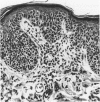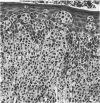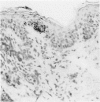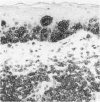Abstract
Canine epitheliotropic lymphoma (mycosis fungoides [MF]) is a spontaneous neoplasm of skin and mucous membranes that occurs in old dogs (mean age 11 years) and has no breed predilection. The lesions evolve from a patch-plaque stage with prominent epitheliotropism into a tumor stage in which distant metastasis is observed. Unlike human MF, epitheliotropism of the lymphoid infiltrate is still prominent in tumor stage lesions. Tropism of the lymphoid infiltrate for adnexal structures, especially hair follicles and apocrine sweat glands, was marked in all clinical stages of canine MF. Twenty-three cases of MF were subjected to extensive immunophenotypic analysis in which reagents specific for canine leukocyte antigens and fresh frozen tissue sections of the canine lesions were used. Canine MF proved to be a T cell lymphoma in which the epitheliotropic lymphocytes consistently expressed CD3 (22 cases) and CD8 (19 cases); CD3+CD4-CD8- lymphocytes predominated in the remaining 4 cases. In this regard, canine MF clearly differed from human MF in which a CD4 immunophenotype predominates in the T cell infiltrate. Lack of expression of CD45RA by epitheliotropic T cells and intense expression of a beta 1 integrin (VLA-4-like) suggested that T cells in canine MF belonged to the memory subpopulation, as has been suggested for T cells in human MF. Pan-T cell antigen loss or discordant expression also proved useful as phenotypic indicators of neoplasia in canine MF. Loss of CD5 was observed in epitheliotropic T cells in 63% of cases. Discordance of neoplastic T cell Thy-1 expression was frequently observed between epithelial and dermal or submucosal compartments. We conclude that canine MF still represents a useful spontaneous animal disease model of human cutaneous T cell lymphoma, despite the immunophenotypic differences, which may reflect operational differences between human and canine skin-associated lymphoid tissue.
Full text
PDF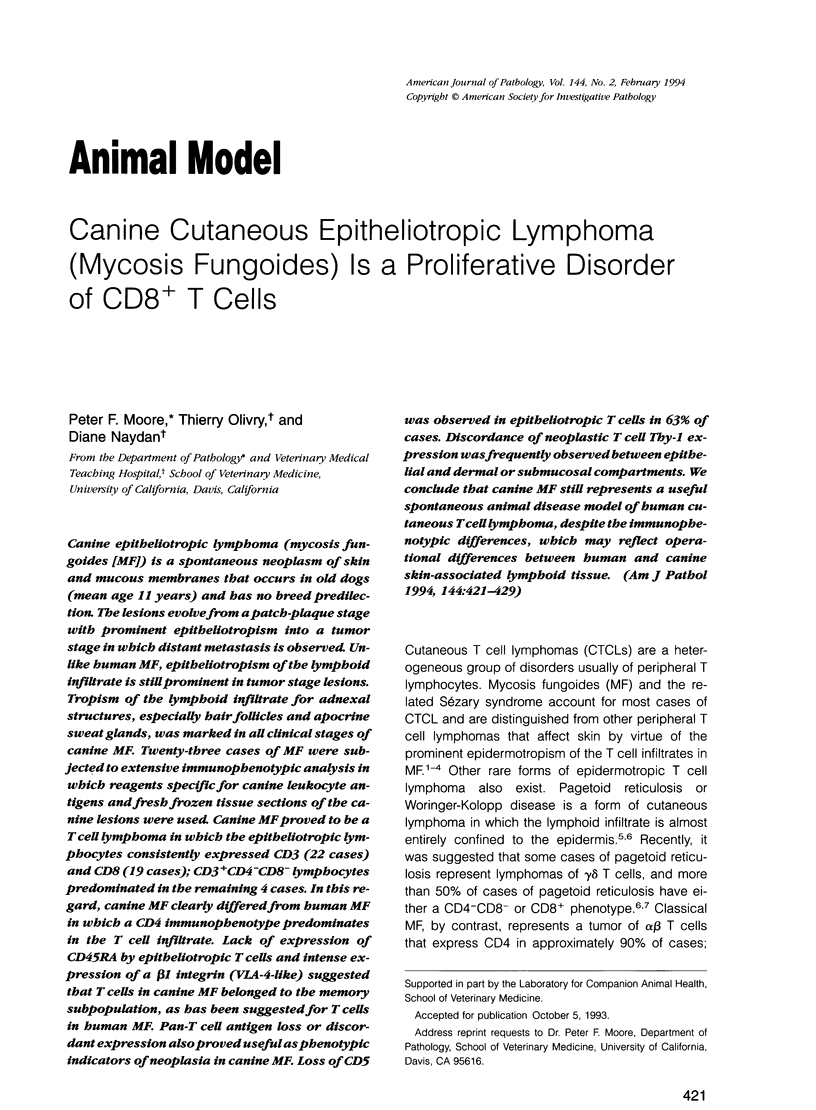
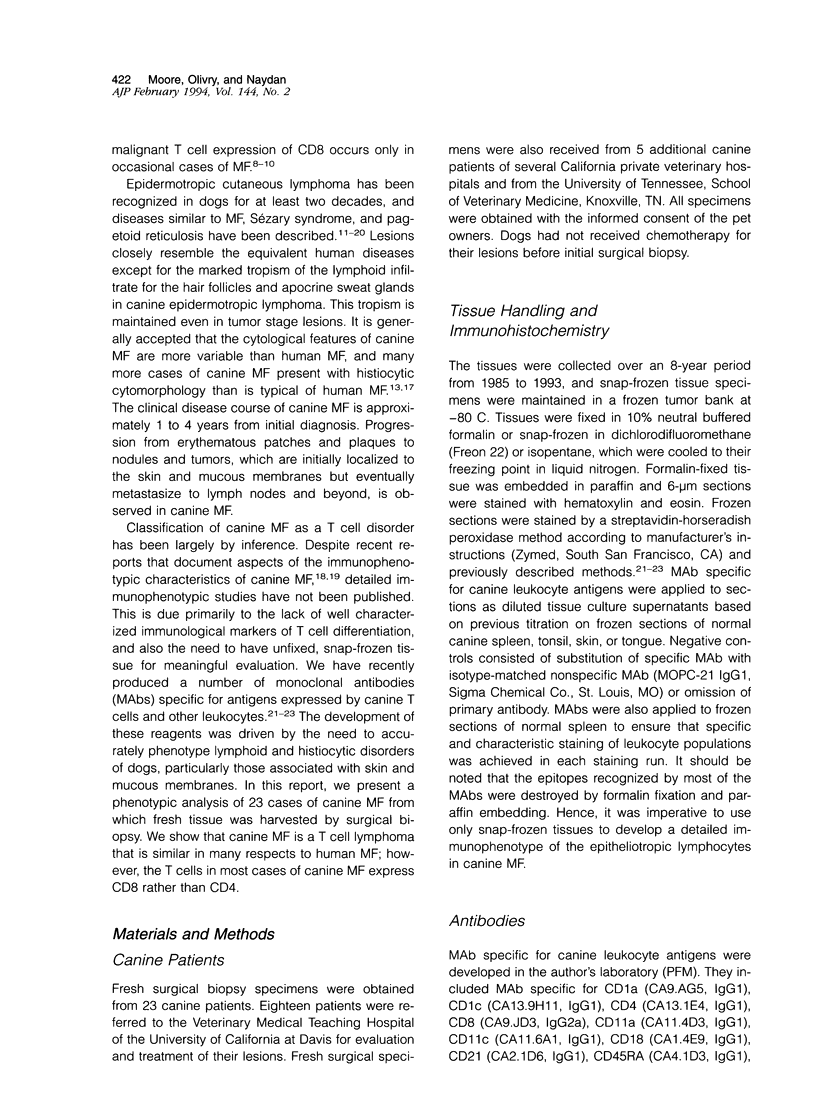

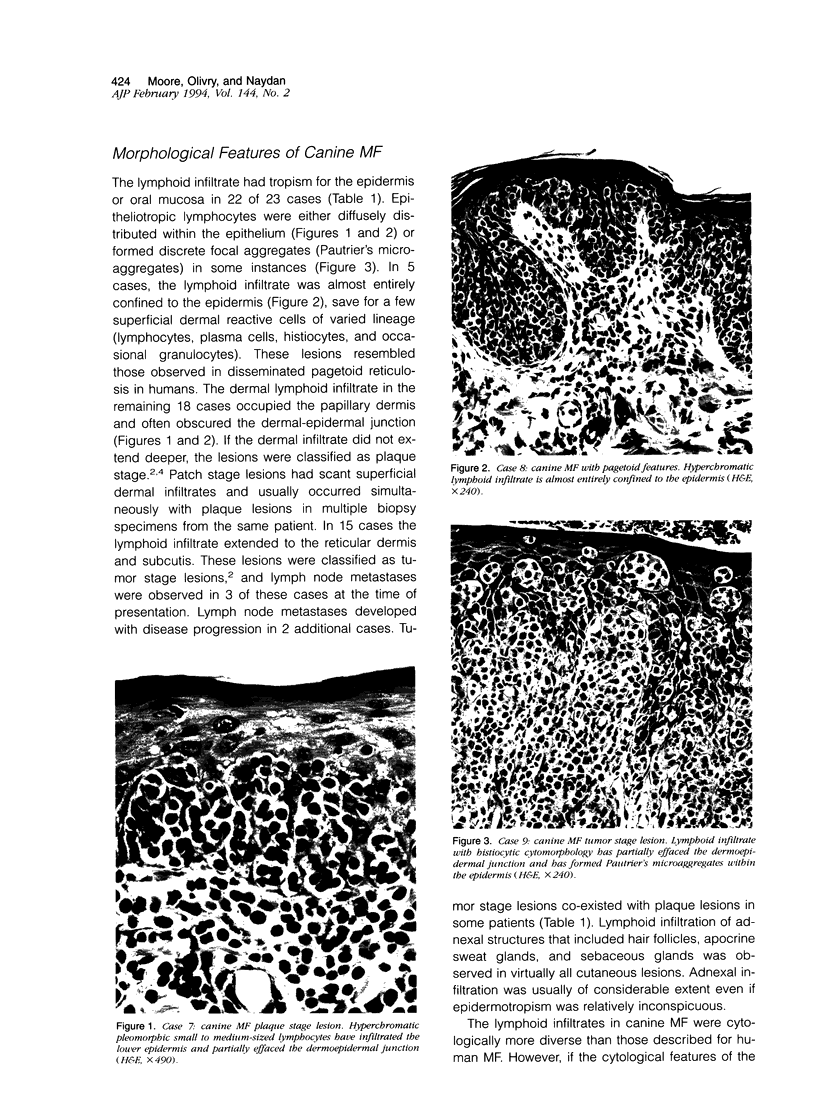
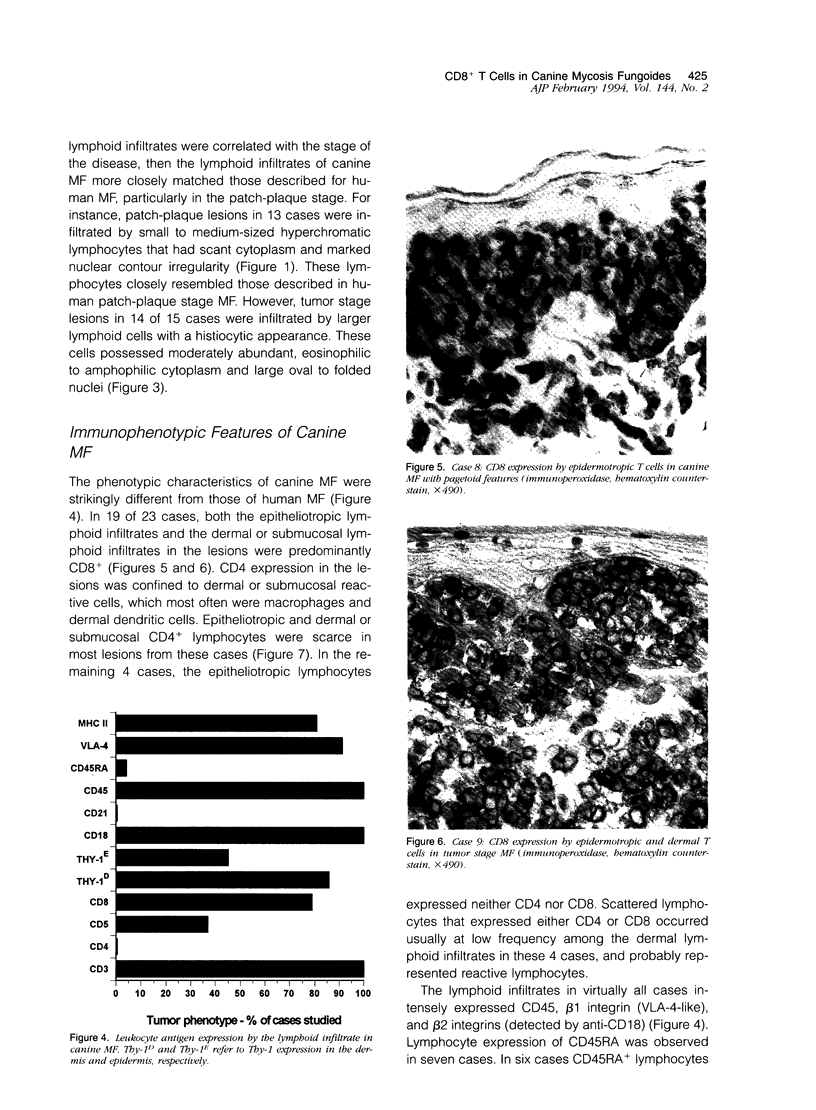
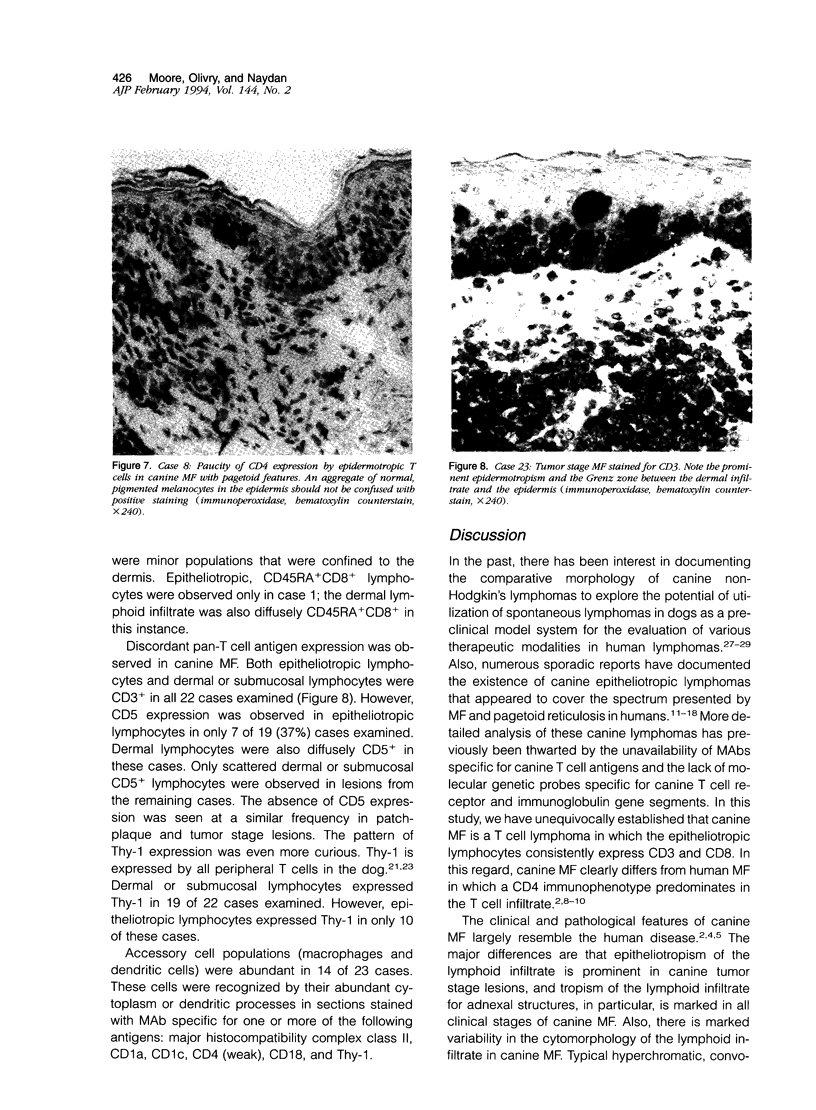

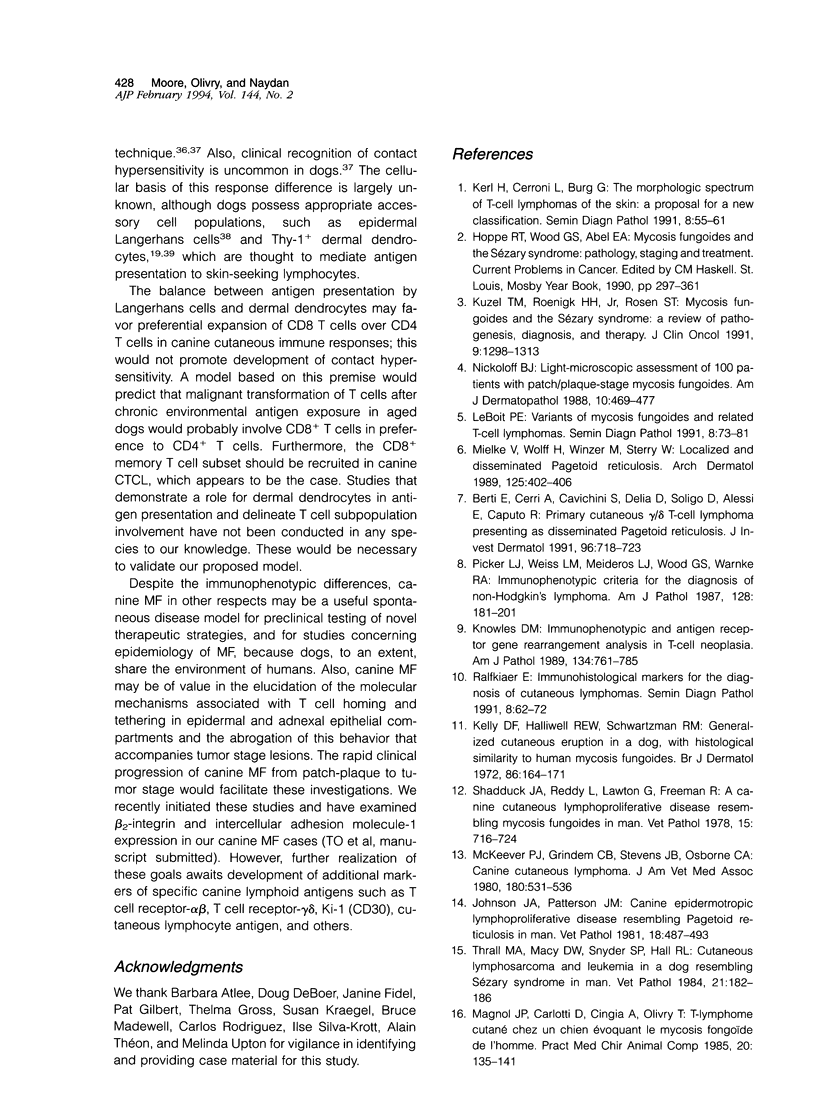

Images in this article
Selected References
These references are in PubMed. This may not be the complete list of references from this article.
- Agnarsson B. A., Vonderheid E. C., Kadin M. E. Cutaneous T cell lymphoma with suppressor/cytotoxic (CD8) phenotype: identification of rapidly progressive and chronic subtypes. J Am Acad Dermatol. 1990 Apr;22(4):569–577. doi: 10.1016/0190-9622(90)70074-r. [DOI] [PubMed] [Google Scholar]
- Appelbaum F. R., Sale G. E., Storb R., Charrier K., Deeg H. J., Graham T., Wulff J. C. Phenotyping of canine lymphoma with monoclonal antibodies directed at cell surface antigens: classification, morphology, clinical presentation and response to chemotherapy. Hematol Oncol. 1984 Apr-Jun;2(2):151–168. doi: 10.1002/hon.2900020205. [DOI] [PubMed] [Google Scholar]
- Berti E., Cerri A., Cavicchini S., Delia D., Soligo D., Alessi E., Caputo R. Primary cutaneous gamma/delta T-cell lymphoma presenting as disseminated pagetoid reticulosis. J Invest Dermatol. 1991 May;96(5):718–723. doi: 10.1111/1523-1747.ep12470953. [DOI] [PubMed] [Google Scholar]
- Carter R. F., Valli V. E., Lumsden J. H. The cytology, histology and prevalence of cell types in canine lymphoma classified according to the National Cancer Institute Working Formulation. Can J Vet Res. 1986 Apr;50(2):154–164. [PMC free article] [PubMed] [Google Scholar]
- Cerio R., Griffiths C. E., Cooper K. D., Nickoloff B. J., Headington J. T. Characterization of factor XIIIa positive dermal dendritic cells in normal and inflamed skin. Br J Dermatol. 1989 Oct;121(4):421–431. doi: 10.1111/j.1365-2133.1989.tb15509.x. [DOI] [PubMed] [Google Scholar]
- Danilenko D. M., Moore P. F., Rossitto P. V. Canine leukocyte cell adhesion molecules (LeuCAMs): characterization of the CD11/CD18 family. Tissue Antigens. 1992 Jul;40(1):13–21. doi: 10.1111/j.1399-0039.1992.tb01952.x. [DOI] [PubMed] [Google Scholar]
- Doe R., Zackheim H. S., Hill J. R. Canine epidermotropic cutaneous lymphoma. Am J Dermatopathol. 1988 Feb;10(1):80–86. doi: 10.1097/00000372-198802000-00011. [DOI] [PubMed] [Google Scholar]
- Fivenson D. P., Beck E. R., Dunstan R. W., Nickoloff B. J., Moore P. F. Dermal dendrocytes and T-cells in canine mycosis fungoides. Support for an animal model of human cutaneous T-cell lymphoma. Cancer. 1992 Oct 15;70(8):2091–2098. doi: 10.1002/1097-0142(19921015)70:8<2091::aid-cncr2820700814>3.0.co;2-2. [DOI] [PubMed] [Google Scholar]
- Greenlee P. G., Filippa D. A., Quimby F. W., Patnaik A. K., Calvano S. E., Matus R. E., Kimmel M., Hurvitz A. I., Lieberman P. H. Lymphomas in dogs. A morphologic, immunologic, and clinical study. Cancer. 1990 Aug 1;66(3):480–490. doi: 10.1002/1097-0142(19900801)66:3<480::aid-cncr2820660314>3.0.co;2-x. [DOI] [PubMed] [Google Scholar]
- Heald P., Buckley P., Gilliam A., Perez M., Knobler R., Kacinski B., Edelson R. Correlations of unique clinical, immunotypic, and histologic findings in cutaneous gamma/delta T-cell lymphoma. J Am Acad Dermatol. 1992 May;26(5 Pt 2):865–870. doi: 10.1016/0190-9622(92)70125-y. [DOI] [PubMed] [Google Scholar]
- Johnson J. A., Patterson J. M. Canine epidermotropic lymphoproliferative disease resembling pagetoid reticulosis in man. Vet Pathol. 1981 Jul;18(4):487–493. doi: 10.1177/030098588101800407. [DOI] [PubMed] [Google Scholar]
- Jones M., Cordell J. L., Beyers A. D., Tse A. G., Mason D. Y. Detection of T and B cells in many animal species using cross-reactive anti-peptide antibodies. J Immunol. 1993 Jun 15;150(12):5429–5435. [PubMed] [Google Scholar]
- Kelly D. F., Halliwell R. E., Schwartzman R. M. Generalized cutaneous eruption in a dog, with histological similarity to human mycosis fungoides. Br J Dermatol. 1972 Feb;86(2):164–171. doi: 10.1111/j.1365-2133.1972.tb16081.x. [DOI] [PubMed] [Google Scholar]
- Kerl H., Cerroni L., Burg G. The morphologic spectrum of T-cell lymphomas of the skin: a proposal for a new classification. Semin Diagn Pathol. 1991 May;8(2):55–61. [PubMed] [Google Scholar]
- Knowles D. M. Immunophenotypic and antigen receptor gene rearrangement analysis in T cell neoplasia. Am J Pathol. 1989 Apr;134(4):761–785. [PMC free article] [PubMed] [Google Scholar]
- Kuzel T. M., Roenigk H. H., Jr, Rosen S. T. Mycosis fungoides and the Sézary syndrome: a review of pathogenesis, diagnosis, and therapy. J Clin Oncol. 1991 Jul;9(7):1298–1313. doi: 10.1200/JCO.1991.9.7.1298. [DOI] [PubMed] [Google Scholar]
- LeBoit P. E. Variants of mycosis fungoides and related cutaneous T-cell lymphomas. Semin Diagn Pathol. 1991 May;8(2):73–81. [PubMed] [Google Scholar]
- Mason D. Y., Cordell J., Brown M., Pallesen G., Ralfkiaer E., Rothbard J., Crumpton M., Gatter K. C. Detection of T cells in paraffin wax embedded tissue using antibodies against a peptide sequence from the CD3 antigen. J Clin Pathol. 1989 Nov;42(11):1194–1200. doi: 10.1136/jcp.42.11.1194. [DOI] [PMC free article] [PubMed] [Google Scholar]
- McKeever P. J., Grindem C. B., Stevens J. B., Osborne C. A. Canine cutaneous lymphoma. J Am Vet Med Assoc. 1982 Mar 1;180(5):531–536. [PubMed] [Google Scholar]
- Michie S. A., Abel E. A., Hoppe R. T., Warnke R. A., Wood G. S. Discordant expression of antigens between intraepidermal and intradermal T cells in mycosis fungoides. Am J Pathol. 1990 Dec;137(6):1447–1451. [PMC free article] [PubMed] [Google Scholar]
- Mielke V., Wolff H. H., Winzer M., Sterry W. Localized and disseminated pagetoid reticulosis. Diagnostic immunophenotypical findings. Arch Dermatol. 1989 Mar;125(3):402–406. [PubMed] [Google Scholar]
- Moore P. F., Rossitto P. V., Danilenko D. M. Canine leukocyte integrins: characterization of a CD18 homologue. Tissue Antigens. 1990 Nov;36(5):211–220. doi: 10.1111/j.1399-0039.1990.tb01831.x. [DOI] [PubMed] [Google Scholar]
- Moore P. F., Rossitto P. V., Danilenko D. M., Wielenga J. J., Raff R. F., Severns E. Monoclonal antibodies specific for canine CD4 and CD8 define functional T-lymphocyte subsets and high-density expression of CD4 by canine neutrophils. Tissue Antigens. 1992 Aug;40(2):75–85. doi: 10.1111/j.1399-0039.1992.tb01963.x. [DOI] [PubMed] [Google Scholar]
- Nash R. A., Scherf U., Storb R. Molecular cloning of the CD3 epsilon subunit of the T-cell receptor/CD3 complex in dog. Immunogenetics. 1991;33(5-6):396–398. doi: 10.1007/BF00216700. [DOI] [PubMed] [Google Scholar]
- Nickoloff B. J. Light-microscopic assessment of 100 patients with patch/plaque-stage mycosis fungoides. Am J Dermatopathol. 1988 Dec;10(6):469–477. doi: 10.1097/00000372-198812000-00001. [DOI] [PubMed] [Google Scholar]
- Nobréus N., Magnusson B., Leandoer L., Attström R. Proceedings: Induction of dinitrochlorobenzene contact sensitivity in dogs. Transfer of sensitivity by thoracic duct lymphocytes and suppression of sensitivity by anti-thymocyte serum. Monogr Allergy. 1974;8(0):100–109. [PubMed] [Google Scholar]
- Picker L. J., Weiss L. M., Medeiros L. J., Wood G. S., Warnke R. A. Immunophenotypic criteria for the diagnosis of non-Hodgkin's lymphoma. Am J Pathol. 1987 Jul;128(1):181–201. [PMC free article] [PubMed] [Google Scholar]
- Ralfkiaer E. Immunohistological markers for the diagnosis of cutaneous lymphomas. Semin Diagn Pathol. 1991 May;8(2):62–72. [PubMed] [Google Scholar]
- Sanders M. E., Makgoba M. W., Sharrow S. O., Stephany D., Springer T. A., Young H. A., Shaw S. Human memory T lymphocytes express increased levels of three cell adhesion molecules (LFA-3, CD2, and LFA-1) and three other molecules (UCHL1, CDw29, and Pgp-1) and have enhanced IFN-gamma production. J Immunol. 1988 Mar 1;140(5):1401–1407. [PubMed] [Google Scholar]
- Shadduck J. A., Reedy L., Lawton G., Freeman R. A canine cutaneous lymphoproliferative disease resembling mycosis fungoides in man. Vet Pathol. 1978 Nov;15(6):716–724. doi: 10.1177/030098587801500603. [DOI] [PubMed] [Google Scholar]
- Smoller B. R., Stewart M., Warnke R. A case of Woringer-Kolopp disease with Ki-1 (CD30) + cytotoxic/suppressor cells. Arch Dermatol. 1992 Apr;128(4):526–529. [PubMed] [Google Scholar]
- Sperling M., Kaudewitz P., Braun-Falco O., Stein H. Reactivity of T cells in mycosis fungoides exhibiting marked epidermotropism with the monoclonal antibody HML-1 that defines a membrane molecule on human mucosal lymphocytes. Am J Pathol. 1989 May;134(5):955–960. [PMC free article] [PubMed] [Google Scholar]
- Thrall M. A., Macy D. W., Snyder S. P., Hall R. L. Cutaneous lymphosarcoma and leukemia in a dog resembling Sézary syndrome in man. Vet Pathol. 1984 Mar;21(2):182–186. doi: 10.1177/030098588402100209. [DOI] [PubMed] [Google Scholar]




